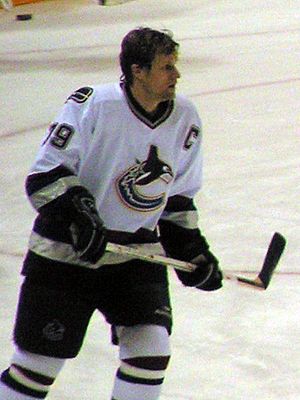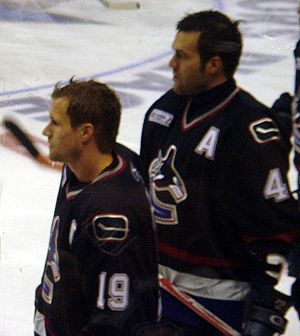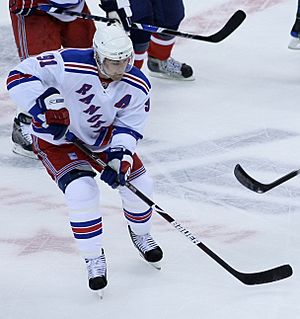Markus Näslund facts for kids
Quick facts for kids Markus Näslund |
|||||||||||||||||||||||||||||||||||||
|---|---|---|---|---|---|---|---|---|---|---|---|---|---|---|---|---|---|---|---|---|---|---|---|---|---|---|---|---|---|---|---|---|---|---|---|---|---|
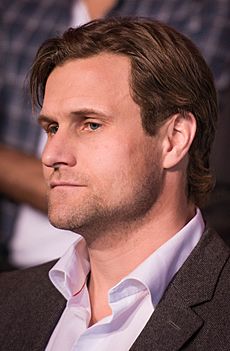
Näslund in 2015
|
|||||||||||||||||||||||||||||||||||||
| Born | 30 July 1973 Örnsköldsvik, Sweden |
||||||||||||||||||||||||||||||||||||
| Height | 6 ft 0 in (183 cm) | ||||||||||||||||||||||||||||||||||||
| Weight | 191 lb (87 kg; 13 st 9 lb) | ||||||||||||||||||||||||||||||||||||
| Position | Left wing | ||||||||||||||||||||||||||||||||||||
| Shot | Left | ||||||||||||||||||||||||||||||||||||
| Played for | Modo Hockey Pittsburgh Penguins Vancouver Canucks New York Rangers |
||||||||||||||||||||||||||||||||||||
| National team | |||||||||||||||||||||||||||||||||||||
| NHL Draft | 16th overall, 1991 Pittsburgh Penguins |
||||||||||||||||||||||||||||||||||||
| Playing career | 1990–2010 | ||||||||||||||||||||||||||||||||||||
|
Medal record
|
|||||||||||||||||||||||||||||||||||||
Markus Sten Näslund (born July 30, 1973) is a Swedish former professional ice hockey player. He also used to be the general manager for Modo Hockey in Sweden. Markus played in the National Hockey League (NHL) for the Pittsburgh Penguins, Vancouver Canucks, and New York Rangers. He also played in Sweden's top league, the Elitserien, with Modo Hockey.
Fans called him "Nazzy" in Vancouver and "Macke" or "Mackan" in Sweden. He was famous for his amazing offensive skills, especially his powerful wrist shot and how he handled the puck.
Markus started playing junior hockey with Modo, then became a professional player for their top team in 1990–91. The Pittsburgh Penguins picked him 16th overall in the 1991 NHL Entry Draft, and he joined the NHL in 1993–94. In 1996, Näslund was traded to the Vancouver Canucks. He played there for 12 years, including a team record 8 years as captain.
With the Canucks, Näslund was the team's top scorer for 7 seasons. He was chosen as a first team All-Star three times (in 2002, 2003, and 2004). In 2003, he won the Lester B. Pearson Award (now called the Ted Lindsay Award). He also finished second for the Hart Memorial Trophy, Art Ross Trophy, and Rocket Richard Trophy that year. He won the Cyclone Taylor Trophy as the Canucks' most valuable player five times. He also won the Cyrus H. McLean Trophy as the leading point-scorer for seven years in a row. These are both club records. He became the Canucks' all-time leader in goals and points.
In 2008, Näslund signed with the New York Rangers and played one season there. He then announced his retirement from the NHL after 15 seasons. In 2009–10, he returned to play for Modo before retiring again. In December 2010, the Canucks retired his jersey number, making him only the third player to receive this honor.
Markus also played for the Swedish national team. He competed in two European Junior Championships, two World Junior Championships, four World Championships, two World Cups, and one Winter Olympics. He holds the World Junior record for most goals in a single tournament, scoring 13 in 1993. He also won two silver medals at that competition. In the World Championships, he won a silver medal in 1993 and two bronze medals in 1999 and 2002. On April 21, 2014, Näslund was inducted into the Swedish Hockey Hall Of Fame.
Contents
Early Life and Hockey Start
Markus Näslund was born on July 30, 1973, in Örnsköldsvik, Sweden. This city is famous for producing many NHL players. His childhood friend and future teammate, Peter Forsberg, also came from there. Other famous players from Örnsköldsvik include Victor Hedman and the Sedin twins, Henrik and Daniel Sedin.
Growing up, Markus looked up to Swedish hockey star Håkan Loob. He spent most of his time playing hockey at an outdoor rink in his neighborhood. When he was 14, Näslund played for the all-star team from Ångermanland. They won a national championship for players under 16 at TV-pucken in 1988. Markus received the Sven Tumba Award as the best forward in the tournament.
Markus and Peter Forsberg were born only 10 days apart. They became good friends while playing on different youth teams. Later, they joined the Ångermanland team together. They then played on the same team for Modo Hockey and the Swedish national team. They even went to high school together and had summer jobs at the same electrical company.
Playing Career Highlights
Starting with Modo Hockey
At 15, Näslund played for Örnsköldsviks SK in Sweden's third-tier league. He scored 7 goals and 13 points in 14 games. The next season, in 1989–90, Näslund joined the Modo Hockey organization. He played in Sweden's top junior league, the J20 SuperElit. He and Peter Forsberg played on a very strong line together. They helped Modo win two junior championships in a row.
In 1990–91, Näslund joined Modo's professional team in the Elitserien, Sweden's main league. He wore jersey number 19, which he later used for the Swedish national teams. In his first season, he scored 10 goals and 19 points. This was a record for a 17-year-old in the league at the time.
After that season, the Pittsburgh Penguins drafted Näslund 16th overall in the 1991 NHL Entry Draft. The Penguins' general manager, Craig Patrick, thought Näslund and Forsberg were the best two players in the draft after Eric Lindros.
Näslund stayed in Sweden with Modo for two more years. He led the team with 39 points in 1991–92. He scored the same number of points the next season. He then helped Modo reach the quarterfinals of the Elitserien playoffs.
Time with the Pittsburgh Penguins
After the 1992–93 season, Näslund's contract with Modo ended. He joined the Penguins for the 1993–94 season. He chose number 29 because his usual number 19 was already taken by teammate Bryan Trottier. He played his first NHL game on October 5, 1993. Five days later, he got his first NHL point, an assist. His first NHL goal came on November 9, 1993.
When he first joined the NHL, Näslund found it tough. He was sometimes sent to the Penguins' minor league team, the Cleveland Lumberjacks. He finished his first season with 4 goals and 7 assists in 71 games. The Penguins made the playoffs, but Näslund did not play.
The next season was shorter because of a player lockout. He continued to play for both Pittsburgh and Cleveland. He scored 2 goals and 4 points in 14 games with Pittsburgh. He was frustrated by being sent to the minor league team and even asked to be traded.
In the 1995–96 season, Näslund started strong. He had 36 points in 29 games. He scored his first NHL hat-trick on November 28, 1995. However, his scoring slowed down later in the season.
Becoming a Star with the Vancouver Canucks
Joining Vancouver and Becoming Captain
On March 20, 1996, Näslund was traded to the Vancouver Canucks. This trade is now seen as one of the most important in NHL history. The Penguins received Alek Stojanov, who played only a few games for them. Näslund, however, became a huge star for the Canucks.
He played his first game with Vancouver two days after the trade. He didn't score in his first nine games. But in the last game of the season, he scored a hat-trick, helping the Canucks make the playoffs. He finished the season with 22 goals and 55 points combined. He played in his first NHL playoffs, scoring his first playoff goal against Patrick Roy.
In his first full season with the Canucks (1996–97), he scored 21 goals and 41 points. The Canucks did not make the playoffs that year. At the start of the 1997–98 season, Näslund asked for another trade after his coach benched him.
In the next season, Näslund became a key offensive player for the Canucks. Injuries to other players meant he got more ice time. He scored his third NHL hat-trick on December 5, 1998. He was named to his first NHL All-Star Game. He led the team with 36 goals and 66 points. He won the Cyclone Taylor Trophy as the Canucks' most valuable player. He also won the team's Most Exciting Player Award.
During the Canucks' training camp in Sweden in 2000–01, Näslund was named team captain on September 15, 2000. He was the first European-born captain in Canucks history. He said that Mark Messier, who he played with before, was his biggest influence. In his first year as captain, Näslund kept getting better. He was named to his second NHL All-Star Game. With 10 games left, he broke his leg on March 16, 2001. He needed surgery and missed the rest of the season. At the time of his injury, his 41 goals were tied for third in the league. He received his first of three Viking Awards, given to the best Swedish player in the NHL.
The Canucks made the playoffs that year but were swept in the first round. This marked a new era for the team. Näslund, along with Todd Bertuzzi, Brendan Morrison, Ed Jovanovski, and Mattias Öhlund, formed a new core group. He said growing up together with this group was his "fondest memory" in the NHL.
The "West Coast Express" Line
Näslund signed a new three-year contract with the Canucks in June 2001. He spent the summer recovering from his leg injury. In 2001–02, he scored 40 goals and 90 points, ranking second in the league. This season also saw the start of one of the most famous lines in hockey. Näslund and Bertuzzi were already playing together. On January 9, 2002, coach Marc Crawford put Brendan Morrison as their center. This trio was called the "West Coast Express".
The "West Coast Express" line helped Näslund earn NHL Player of the Month in January 2002. He was chosen for the 2002 NHL All-Star Game and scored the winning goal. The Canucks made the playoffs but lost to the Detroit Red Wings. After the season, Näslund was named an NHL first team All-Star. He also finished fifth in voting for the Hart Memorial Trophy.
In 2002–03, with the "West Coast Express" playing a full season, Näslund had his best year ever. He scored 48 goals and 104 points, finishing second in the league in both. He also led the league with 54 powerplay points and 12 game-winning goals. His linemates, Bertuzzi and Morrison, also had career-best seasons.
Early in the season, Näslund scored his eighth NHL hat-trick. On December 14, he scored a career-high four goals in one game, tying a Canucks record. He was named to his third straight All-Star Game. He also had a six-point night (one goal, five assists) on February 14, 2003. This win helped the Canucks set a team record with a 14-game unbeaten streak. On March 27, he got his 100th point of the season, becoming only the third Canuck to reach that mark.
The Canucks lost their division title on the last day of the season. Näslund had been leading the league in points and goals, but was passed by other players. He apologized to the fans, saying the team "choked." In the 2003 playoffs, Vancouver won their first series in seven games. However, they lost the next round after leading the series 3-1. Näslund finished the playoffs with a career-high 14 points in 14 games.
After the season, Näslund won the Lester B. Pearson Award. This award is given to the league's best player, as voted by the players themselves. He was the first Swedish player and first Canucks player to win it. He was also a finalist for the Hart Memorial Trophy, given to the league's most valuable player. He finished second in the voting.
In 2003–04, Näslund led the Canucks in scoring for the sixth year in a row. He had 84 points (fourth in the league) and 35 goals (seventh). He scored his second career four-goal game on December 9, 2003. He was chosen as captain for the Western Conference at the 2004 NHL All-Star Game.
During a game on February 16, 2004, Näslund was hit in the head by an opposing player. He got a minor concussion and missed three games. This incident led to a lot of trouble for his teammate Todd Bertuzzi, who later retaliated against the player who hit Näslund. Näslund was deeply affected by this.
Despite Bertuzzi's absence, Näslund led the Canucks to win their division. They lost in the first round of the 2004 playoffs in a close seven-game series. Näslund finished the playoffs with nine points. From 2001–02 to 2003–04, Näslund scored the most goals (123) and points (278) of any NHL player.
During the NHL lockout, Näslund returned to play for Modo Hockey in Sweden. He played 13 games and scored 17 points.
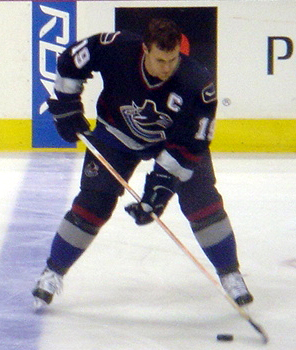
After the Lockout
When the NHL started playing again in 2005–06, Näslund signed a new three-year contract with the Canucks. He led the team in scoring for a record seventh year in a row, with 32 goals and 79 points. However, the Canucks missed the playoffs that season.
Many changes were made to the team. His longtime linemate Bertuzzi was traded. A new coach, Alain Vigneault, brought a more defensive style of play. Näslund's scoring continued to decrease in 2006–07. He scored his 300th goal as a Canuck on October 14, 2006, tying the team record. He soon broke the record with his 301st goal. He finished the season with 60 points, his lowest since 1997–98. His teammate Daniel Sedin led the team in scoring that year.
In 2007–08, Näslund reached more milestones. On November 21, 2007, he tied the Canucks' record for most hat-tricks with 10. On December 5, he became the Canucks' all-time leading point-scorer, passing Trevor Linden with 725 points. On January 17, 2008, Näslund played his 1,000th career game. He finished the season with 25 goals and 55 points.
As his contract was ending, Näslund said he was frustrated with the coach's defensive style. He decided to explore other options.
Playing for the New York Rangers
On July 3, 2008, Näslund signed a two-year contract with the New York Rangers. He said New York was where he wanted to go. He left Vancouver as the Canucks' all-time leader in goals (346) and points (756). His eight years as captain also matched the longest in team history.
Näslund chose to wear #91 with the Rangers. On October 3, he was named an alternate captain. The next day, he scored his first goal as a Ranger. In his only season with the Rangers, Näslund led the team in goals with 24 and was fourth in points with 46. He added three points in the playoffs, but the Rangers were eliminated in the first round.
On May 4, 2009, at age 35, he announced his retirement from the NHL. When he retired, Näslund was second among all-time Swedish players in goals (395) and fifth in points (869). He was also fourth in games played (1,117).
Returning to Modo and Final Retirement
Näslund moved back to Sweden with his family in 2009. His friend Peter Forsberg was trying to return to the NHL and was playing with Modo. On November 17, 2009, Näslund announced he was coming out of retirement to join Forsberg with Modo. He said he and Forsberg wanted to help their old club, which was having financial problems and was in last place. They played without salary.
Näslund played his first game back with Modo on November 28, getting an assist on a goal by Forsberg. He scored his first goal since returning on December 8. He even got a hat-trick on February 27. He played in 29 games, scoring 10 goals and 19 assists. Modo improved but just missed the playoffs. After that season, Näslund confirmed his second retirement.
At the start of the 2010–11 NHL season, the NHL honored Näslund with a tribute. On December 11, 2010, the Canucks retired his number 19 jersey. His family, former teammates, and coaches were there. The team also started a program to provide sports equipment for children in need, in honor of Näslund and his wife's charity work. He became the third player in Canucks history to have his jersey retired.
International Play
Näslund first played for Sweden internationally in 1989. The next year, he played in the 1990 European Junior Championships (for players under 18). Sweden won a gold medal. In 1991, he led the tournament with 14 goals.
He continued to play in junior tournaments, winning silver medals at the 1992 and 1993 World Junior Championships. In 1992, he had 10 points, including 8 goals. In 1993, when Sweden hosted the tournament, Näslund set a record for most goals in a single year with 13. He played on a line with Forsberg and Niklas Sundström. His 24 points were second in the tournament. He was named to the Tournament All-Star team.
Näslund made his debut for the senior Swedish team at the 1993 World Championships. He won another silver medal with Sweden. He played in the 1996 World Championships and the 1996 World Cup. In 1999, he helped Sweden win a bronze medal at the World Championships, scoring 10 points.
In 2002, Näslund played in his first and only Winter Olympics at the Salt Lake City Games. He scored two goals against Germany. Sweden was expected to win a medal but lost to Belarus in a big upset. He finished the tournament with two goals and an assist.
Several months later, he played in his final World Championships. Sweden won the bronze medal. He played in his final international competition at the 2004 World Cup of Hockey. He was chosen for the 2006 Winter Olympics but could not play due to an injury. Sweden went on to win the gold medal.
Playing Style
Näslund was known as a very skilled offensive player. He was a good skater and excellent at handling the puck. His wrist shot was especially famous for being very accurate. He scored many of his goals on the powerplay. His first Canucks coach, Marc Crawford, said Näslund could "take a play where there's nothing...and turn it into a scoring chance."
Näslund's best years came when he played with Bertuzzi and Morrison. His skill and goal-scoring were perfectly matched by Morrison's playmaking and Bertuzzi's strength. They played a fast and exciting style of hockey.
As captain of the Canucks for eight years, Näslund was a "leader by example." He showed his teammates how to work hard on the ice. Some people criticized him for not being vocal enough as captain, especially later in his career. However, former teammates said he was a quiet leader who spoke when it was important. They also praised him for his honesty and how he treated everyone well. The Sedin twins, in particular, said he helped them a lot when they were young players.
His scoring went down after the 2004–05 lockout. This was partly because of the new coach's defensive style. Also, Bertuzzi leaving the team affected Näslund's play. Some people also thought the effects of his concussion in 2004, and the stress from the incident, might have affected his game.
Life After Playing Hockey
Management Career
In December 2010, Näslund was named the general manager of the Modo organization. He was in charge of all their sports clubs. In his first season, the hockey club finished last in the top league. They had to play games to avoid being moved down to a lower league, which they successfully did.
In April 2011, Peter Forsberg joined Näslund on Modo's management team as the assistant manager.
Personal Life and Charity
Markus and his wife Lotta have three children: Rebecca, Isabella, and Alex. During his NHL career, they spent their summers in Sweden. Like other Swedish players, Näslund wanted to raise his children in his home country. He also loved his time in Vancouver.
After retiring from the NHL in 2009, Markus and his family moved back to Sweden. He started coaching his son's minor-league hockey team before becoming Modo's general manager. He also got involved in real estate development.
In 2002, Näslund and Forsberg started "Icebreakers." This organization raises money for sick and disabled children in their home region of Västernorrland. They put together a team of Swedish all-stars to play charity games.
In Vancouver, Näslund had a program called "Nazzy's Suite 19." It gave children from charities a chance to watch Canucks games from a special suite. This program was later taken over by goalie Roberto Luongo. Näslund also visited children's hospitals and supported the Canucks For Kids Fund. He even appeared in a public service announcement about mental health.
After retiring from the NHL, he joined a tour for the NHLPA's Goals and Dreams program. This charity donates hockey equipment to children who can't afford it.
Endorsements
When he was at the top of his career, Näslund signed many endorsement deals. He worked with companies like Nike Bauer and Electronic Arts (EA). In 2004, EA Sports chose Näslund to be on the cover of their video game, NHL 2005. He was also on the European cover of NHL 2000.
Career Statistics
Regular season and playoffs
| Regular season | Playoffs | |||||||||||||
|---|---|---|---|---|---|---|---|---|---|---|---|---|---|---|
| Season | Team | League | GP | G | A | Pts | PIM | GP | G | A | Pts | PIM | ||
| 1988–89 | Örnsköldsviks SK | SWE III | 14 | 7 | 6 | 13 | — | — | — | — | — | — | ||
| 1989–90 | Modo Hockey | J20 | 33 | 43 | 35 | 78 | 20 | — | — | — | — | — | ||
| 1989–90 | Modo Hockey | Allsv | 2 | 1 | 1 | 2 | 0 | 5 | 0 | 0 | 0 | 0 | ||
| 1990–91 | Modo Hockey | SEL | 32 | 10 | 9 | 19 | 14 | — | — | — | — | — | ||
| 1991–92 | Modo Hockey | SEL | 39 | 22 | 18 | 40 | 52 | — | — | — | — | — | ||
| 1992–93 | Modo Hockey | J20 | 2 | 4 | 1 | 5 | 2 | — | — | — | — | — | ||
| 1992–93 | Modo Hockey | SEL | 39 | 22 | 17 | 39 | 67 | 3 | 3 | 2 | 5 | 0 | ||
| 1993–94 | Pittsburgh Penguins | NHL | 71 | 4 | 7 | 11 | 27 | — | — | — | — | — | ||
| 1993–94 | Cleveland Lumberjacks | IHL | 5 | 1 | 6 | 7 | 4 | — | — | — | — | — | ||
| 1994–95 | Pittsburgh Penguins | NHL | 14 | 2 | 2 | 4 | 2 | — | — | — | — | — | ||
| 1994–95 | Cleveland Lumberjacks | IHL | 7 | 3 | 4 | 7 | 6 | 4 | 1 | 3 | 4 | 8 | ||
| 1995–96 | Pittsburgh Penguins | NHL | 66 | 19 | 33 | 52 | 36 | — | — | — | — | — | ||
| 1995–96 | Vancouver Canucks | NHL | 10 | 3 | 0 | 3 | 6 | 6 | 1 | 2 | 3 | 8 | ||
| 1996–97 | Vancouver Canucks | NHL | 78 | 21 | 20 | 41 | 30 | — | — | — | — | — | ||
| 1997–98 | Vancouver Canucks | NHL | 76 | 14 | 20 | 34 | 56 | — | — | — | — | — | ||
| 1998–99 | Vancouver Canucks | NHL | 80 | 36 | 30 | 66 | 74 | — | — | — | — | — | ||
| 1999–00 | Vancouver Canucks | NHL | 82 | 27 | 38 | 65 | 64 | — | — | — | — | — | ||
| 2000–01 | Vancouver Canucks | NHL | 72 | 41 | 34 | 75 | 58 | — | — | — | — | — | ||
| 2001–02 | Vancouver Canucks | NHL | 81 | 40 | 50 | 90 | 50 | 6 | 1 | 1 | 2 | 2 | ||
| 2002–03 | Vancouver Canucks | NHL | 82 | 48 | 56 | 104 | 52 | 14 | 5 | 9 | 14 | 18 | ||
| 2003–04 | Vancouver Canucks | NHL | 78 | 35 | 49 | 84 | 58 | 7 | 2 | 7 | 9 | 2 | ||
| 2004–05 | Modo Hockey | SEL | 13 | 8 | 9 | 17 | 8 | 6 | 0 | 1 | 1 | 10 | ||
| 2005–06 | Vancouver Canucks | NHL | 81 | 32 | 47 | 79 | 66 | — | — | — | — | — | ||
| 2006–07 | Vancouver Canucks | NHL | 82 | 24 | 36 | 60 | 54 | 12 | 4 | 1 | 5 | 16 | ||
| 2007–08 | Vancouver Canucks | NHL | 82 | 25 | 30 | 55 | 46 | — | — | — | — | — | ||
| 2008–09 | New York Rangers | NHL | 82 | 24 | 22 | 46 | 57 | 7 | 1 | 2 | 3 | 10 | ||
| 2009–10 | Modo Hockey | SEL | 29 | 10 | 19 | 29 | 20 | — | — | — | — | — | ||
| SEL totals | 152 | 72 | 72 | 144 | 161 | 9 | 3 | 3 | 6 | 10 | ||||
| NHL totals | 1,117 | 395 | 474 | 869 | 736 | 52 | 14 | 22 | 36 | 56 | ||||
International
| Year | Team | Event | GP | G | A | Pts | PIM | |
|---|---|---|---|---|---|---|---|---|
| 1990 | Sweden | EJC | 6 | 0 | 0 | 0 | 2 | |
| 1991 | Sweden | EJC | 6 | 14 | 2 | 16 | 14 | |
| 1992 | Sweden | WJC | 7 | 8 | 2 | 10 | 12 | |
| 1993 | Sweden | WJC | 7 | 13 | 11 | 24 | 33 | |
| 1993 | Sweden | WC | 8 | 1 | 1 | 2 | 14 | |
| 1996 | Sweden | WC | 1 | 0 | 0 | 0 | 0 | |
| 1996 | Sweden | WCup | 1 | 0 | 0 | 0 | 2 | |
| 1999 | Sweden | WC | 10 | 6 | 4 | 10 | 16 | |
| 2002 | Sweden | Oly | 4 | 2 | 1 | 3 | 0 | |
| 2002 | Sweden | WC | 3 | 1 | 2 | 3 | 0 | |
| 2004 | Sweden | WCup | 4 | 0 | 3 | 3 | 0 | |
| Junior totals | 26 | 35 | 15 | 50 | 61 | |||
| Senior totals | 31 | 10 | 11 | 21 | 32 | |||
All-Star Games
| Year | Location | G | A | P | |
|---|---|---|---|---|---|
| 1999 | Tampa Bay | 0 | 1 | 1 | |
| 2001 | Denver | 1 | 0 | 1 | |
| 2002 | Los Angeles | 2 | 1 | 3 | |
| 2003 | Florida | 0 | 1 | 1 | |
| 2004 | Minnesota | 0 | 3 | 3 | |
| All-Star totals | 3 | 6 | 9 | ||
Awards and Honors
Sweden
| Award | Year(s) |
|---|---|
| Sven Tumba Award (TV-pucken best forward) | 1988 |
| Viking Award (NHL's best Swedish player) | 2001, 2003, 2004 |
International
| Award | Year(s) |
|---|---|
| World Junior All-Star team | 1993 |
NHL
| Award | Year(s) |
|---|---|
| First All-Star team | 2002, 2003, 2004 |
| All-Star Game | 1999, 2001, 2002, 2003, 2004 |
| Lester B. Pearson Award | 2003 |
| EA Sports NHL cover athlete | 2005 |
Vancouver Canucks Team Awards
| Award | Year(s) |
|---|---|
| Cyclone Taylor Award | 1999, 2001, 2002, 2003, 2004 |
| Cyrus H. McLean Trophy | 1999, 2000, 2001, 2002, 2003, 2004, 2006 |
| Most Exciting Player Award | 1999, 2001 |
| Molson Cup | 2001, 2002, 2003 |
Records and Achievements
International
- World Junior Championships' record; most goals, single tournament: 13 (1993)
Vancouver Canucks
- All-time hat-tricks: 10 (tied with Tony Tanti)
- Longest tenured captain: 8 years (2000–08)
- Single-season points by a left wing: 104 (2002–03)
- Single-season goals by a left wing: 48 (2002–03)
- Single-game goals: 4 (twice; 14 December 2002 vs. Edmonton Oilers; 9 December 2003 vs. Pittsburgh Penguins; tied with 10 others)
See also
 In Spanish: Markus Näslund para niños
In Spanish: Markus Näslund para niños


